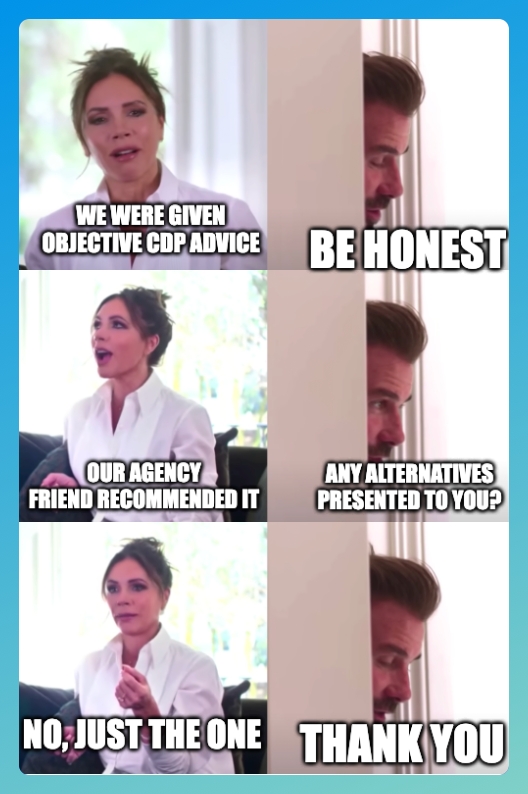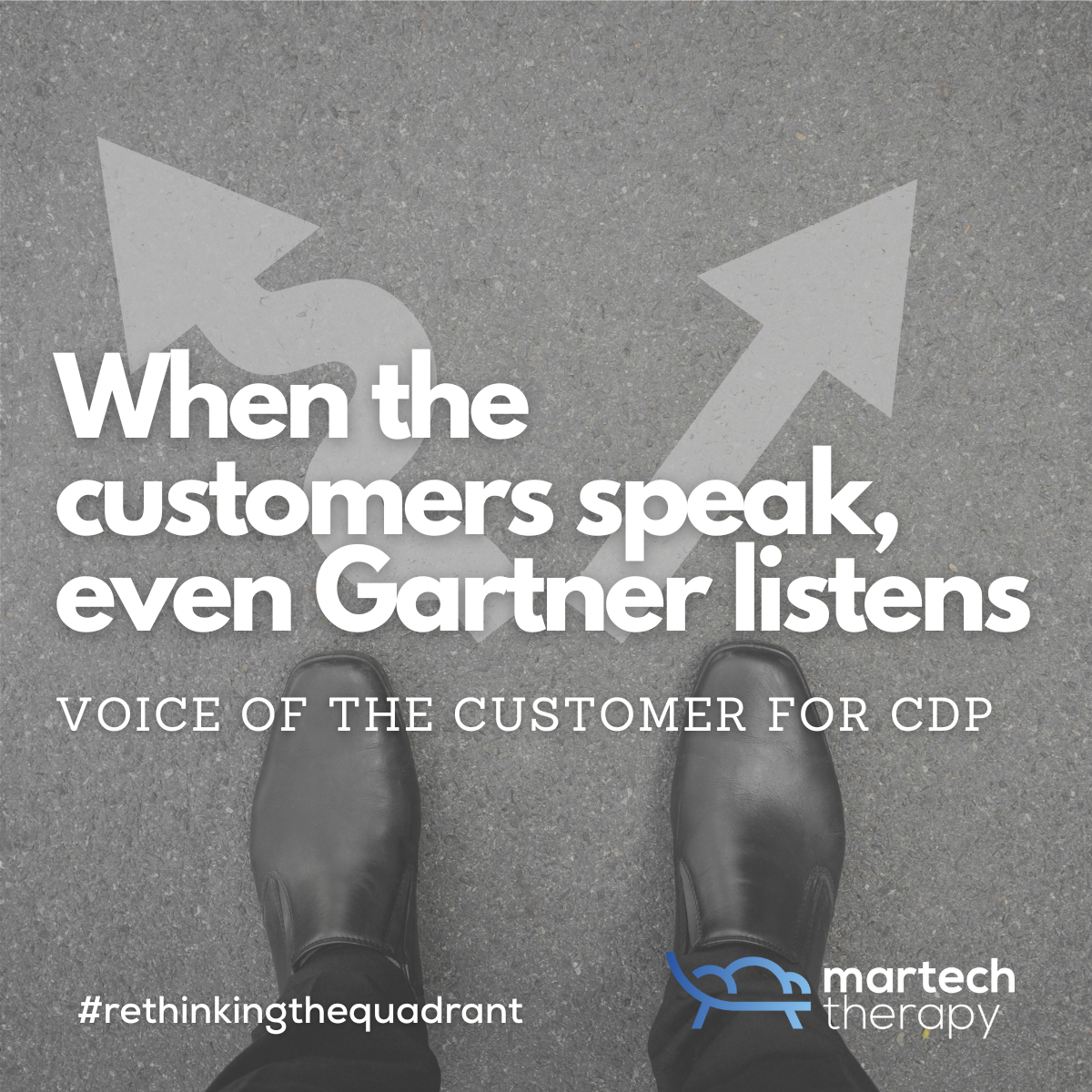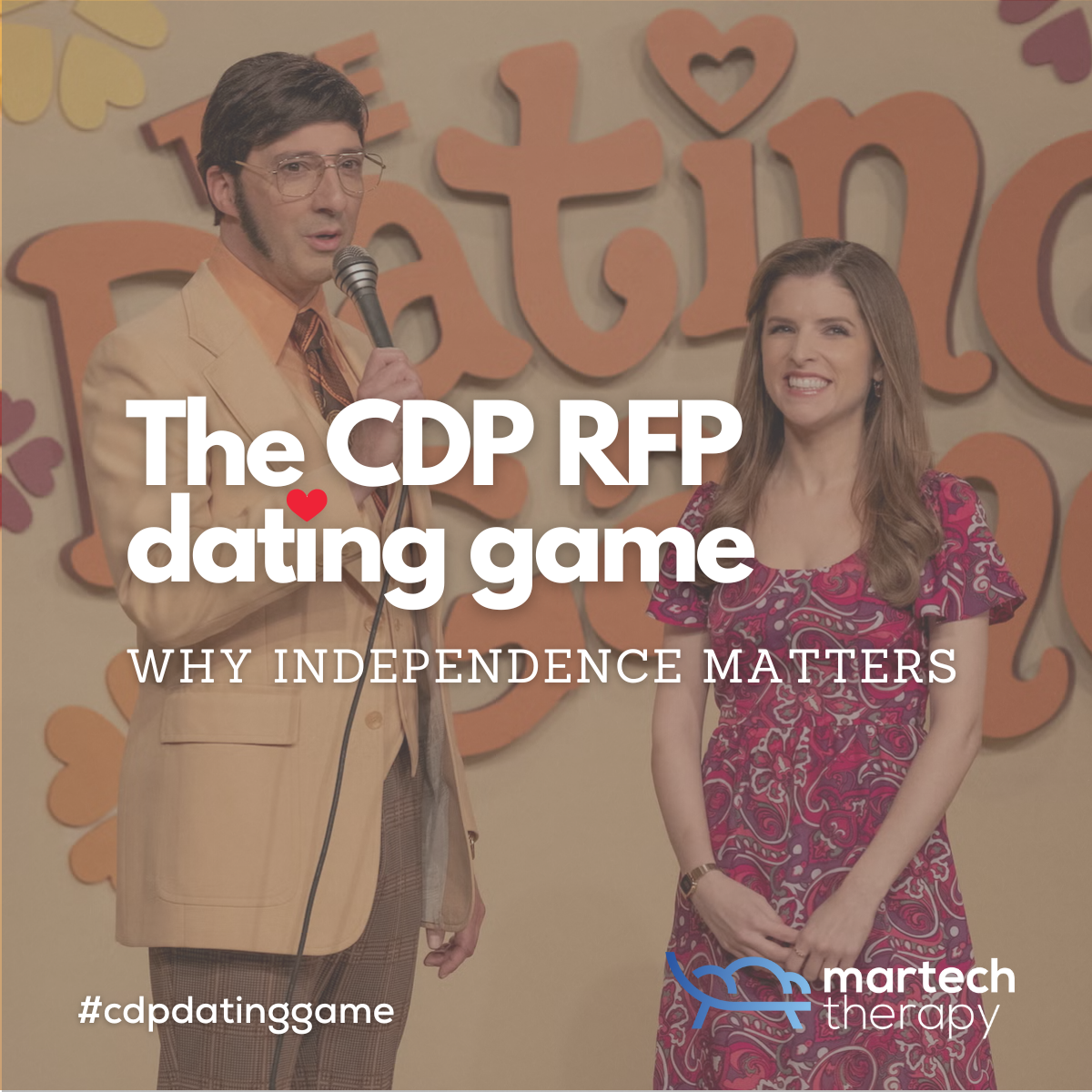On paper, a Request for Proposal (RFP) looks like the fairest way to choose a Customer Data Platform, or anything else for that matter. I am sure if my wife had known about RFPs when we met, I would have been on the receiving side of one. Good thing she didn’t. An RFP is an attempt to make sense of vastly complex and different products through structure, neutrality, and vendor A vs vendor B data in neat columns. But if, like myself, you’ve been in this business for a while, you know the truth 👇🏻
Most RFPs are wired before the first line is even written.
If choosing a CDP feels like playing a dating game, that’s because it often is. Vendors put on their best smile, agencies play matchmaker, analysts whisper advice from the sidelines, and executives sometimes play the role of overbearing parents. It makes for good theater, but the risks are real. Just ask Netflix, which turned The Dating Game into Woman of the Hour, a chilling reminder that surface charm can hide much darker realities. Now, I’m not saying CDP vendors and agencies are serial killers, but I’ve seen how far people will go for financial gain.
I can say that because I’ve been on all sides of the table. Agencies, vendors, end users, and now as an independent contractor. I’ve collected the “been there, done that” t-shirts… and socks. I still, to this day, get asked to work for agencies. And I’ve seen the same games play out again and again.

If you find yourself on the brink of starting an RFP, here’s my free advice 👇🏻
Please don’t assume the process itself guarantees fairness.
The stories that follow are firsthand experiences and are here to help you recognize where the process often gets bent out of shape, and why independence makes all the difference.
🛑 Wait, before we continue, please let me emphasize that I am not here to burn bridges. I am here to let you all know that we can do better. Better for the customer, better for continued business, better for trust.
Agencies aren’t neutral, they’re invested
Agencies love to pitch themselves as impartial advisors. But when I worked for one, an analytics agency around 15 years ago, the game was obvious. We had a sweetheart deal with an analytics vendor. We bought “hits” in bulk, literally the golden currency at the time, at a massive discount, then resold the tool cheap to clients. Looked like a bargain.
The real money? Consultancy. Those tools were a nightmare to implement, and clients were barely out of the starting blocks in terms of maturity. We’d parachute in our consultants at high margin, and that’s where the profit came from. To this day, I can still recognize an implementation by the first three letters of the account ID and know instantly which agency did it and what kind of mess the client is in.
Fast forward twenty years. The Wild West model is gone, but the principle remains. The big consultancies you come across every day don’t survive on regular partner referral fees of, let’s say, 10%. They survive on license reselling worth millions, often in cases where they know deep inside the product they push is not the best match.
In a recent project, Adobe RT CDP was pushed by a big consultancy with zero alternatives presented. Let that sink in: an uncontested process. Due to decision fatigue on the client side, they were unwilling to spend more time and energy conducting two or three additional three-month risk assessments, so the solution was adopted. Payment started on day one, and there are no people around to implement until day 90. Again, true story.
Is this the client’s, the vendor’s, or the agency’s fault?
But let’s be honest, those dinners, Beyoncé tickets, all expenses paid invites to major conferences don’t come cheap, but they tend to sway many decision makers. Anything to get the contract signed. Independence? Forget it.

And just so I’m clear, I’ve taken referral fees in the past, too. I have tried this way of working. That’s how the industry works. But I came to the conclusion that independence is the only way you can look a client in the eye and tell them the truth. No kickbacks. No hidden incentives. Just the problems that need solving.
Also, let’s be rational and acknowledge that not all agencies are bad actors. I have had plenty of experiences with good ones in the past, Etribes being the most recent one. However, I have noticed that the more invested they are with a specific vendor, the greater the chance of kickbacks is.
Vendors play the language game
Even if you keep the agencies out, you’re left with vendor marketing. And let’s be blunt, I hope you see a recurring theme revealing itself in how I think about the industry, vendors are masters of renaming old things to sound new.
Take reverse ETL. To an engineer, that’s perfectly clear. It’s about moving data from a warehouse into downstream systems like Meta, Google Ads, or an email platform. But marketers? Total blank. So the vendors rebranded it as “activation.” Same process, same mechanics, just wrapped in icing that feels strategic instead of technical and tastes sweet.
Or as one Redditor put it:
It’s a made up marketing term to try and make people believe that there’s some new data management requirement that needs a new toolset to manage it. ETL says nothing about what your source and target are, it is just moving data from A to B or B to A. So Reverse ETL is a meaningless term as ETL has no implicit direction.
I love the quote because of the last three words, “no implicit direction”. It’s a matter of perspective, but my friends, that’s the game. One vocabulary for engineers, another for marketers, a third for executives. Everyone walks out thinking they’ve been promised something different, when in reality, it’s all the same pitch in different clothes. Look, I don’t blame vendors, but I think they can do better at being honest. If people don’t understand what you are trying to sell, educate.
This is where you need a translator, not the Google Translate app type of translation, but someone who doesn’t get dazzled by the jargon and can cut through the icing to the cake underneath.
Analysts live in bubbles
Then there’s the analyst reports. Slick quadrants, clean waves, a comforting sense of authority. Except most of the input comes from vendors, with a few carefully orchestrated customer references sprinkled in.

I’ve heard from highly respected vendor-side people who’ve traveled to these analyst offices and briefed analysts and realized, mid-conversation, that the analyst barely understood the product. Hardly their fault. Martech evolves faster than analyst cycles. When it takes 18 months to produce a report, the market has already sprinted ahead. By the time you’re reading their “latest insights,” half of it, if not more, is obsolete.
👉🏻 So are they useful as a list of logos to start with? Sure.
✋🏻 Are they the right source to guide a multi-million dollar CDP decision? Not a chance.
At a minimum you need to consider the opinions of actual customers.
Politics trumps process
And finally, the politics. Man, oh, man… the source of many of my grey hairs. You can run a tight RFP, narrow the field to three vendors, line up the demos, score them against requirements. All neat, all fair.

Until a board member gets a call from a major vendor and decides their favorite should be back on the shortlist. I’ve seen it multiple times. I'm sure some of you have, too. In any case, we reopened the process, reran the demos, and rescored everything. And guess what? The team rejected the vendor again.
The only thing that changed was the delay, more time, more money, and more frustration. Because one person higher up the ladder wanted to look like they’d “done their due diligence.” Sometimes I wonder if RFP really stands for Real Fucking Politics. Pardon my French… or maybe the P in CDP quietly stands for Politics, too.
Like the dating game, politics adds another layer of performance, who gets to look good, who gets to play kingmaker, and who gets to bend the process. But in the end, it’s still theater, and theater rarely delivers the right long-term partner.
Why independence is the only way forward
Put it all together, the agencies with hidden incentives, vendors playing language games, analysts trapped in their bubbles, executives bending the rules, and you wonder why so many CDP selections go wrong.
This is where independence makes the difference. No vendor ties, no referral fees, no boardroom politics. Just a laser focus on the actual problems you need to solve. A bullshit filter with enough experience to recognize the games, because I’ve played them, seen them, and moved on from them.
And here’s the part most buyers underestimate. The real challenge begins after the contract is signed. A CDP is only as strong as the crew running it. I’ve written before about the importance of training your team before implementation, because no vendor demo prepares you for the day-to-day grind of making data usable. The great thing is that independent guidance doesn’t need to stop at procurement. It extends to helping your crew actually sail the “customer data” ship.
A better way forward
So look, choosing a CDP isn’t just about picking technology. It’s a mirror held up to your organization. Do you have the discipline to focus on the right problems, the strength to push back on salesmanship, the humility to admit you need outside help?
If the answer is no, you’ll end up with the flashiest demo or the highest quadrant ranking, and six months later, a very expensive headache. If the answer is yes, you’ll end up with a CDP that actually works for your business.
At the end of the day, everyone should work with the partner they feel comfortable with. Someone competent and objective enough to guide them toward a solution that meets their needs, not a vendor’s quarterly goals. Because the right CDP isn’t the one that checks the analyst boxes, it’s the one that actually works in the real world.
And getting there requires someone in the room who isn’t selling you anything except the truth.
Subscribe for free to hear more independent advice on Martech topics, including CDPs and CEPs, straight from the source 👇🏻




Discussion